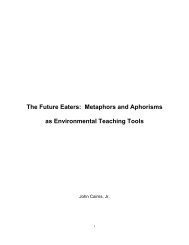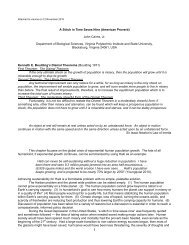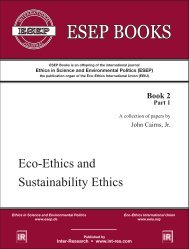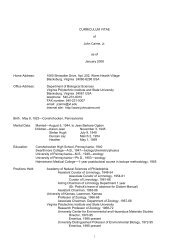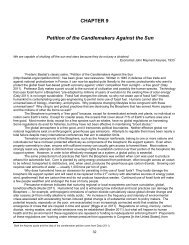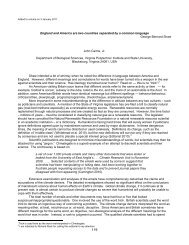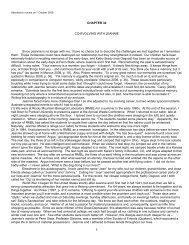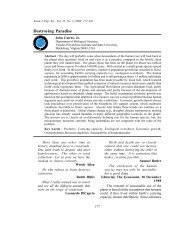View - ResearchGate
View - ResearchGate
View - ResearchGate
You also want an ePaper? Increase the reach of your titles
YUMPU automatically turns print PDFs into web optimized ePapers that Google loves.
Article 27231Mainstream science became much more interested in environmental science and studies, as evidencedby the first Earth Day in 1971. However, humankind still persisted in denying the extent ofthe problem. Denial is not new. Pliny the Elder stated, in the first century, that the stupid ostrichthrusts its head and neck into a bush and imagines that the entire body is concealed (Hardin 1999).Other authors have espoused a no-need-for-concern attitude — everything is fine. Simon (1981)believed in unlimited growth. Naturally, this idea has critics (e.g. Daly 2003). Recently, Lomborg (2001)has created quite a stir, especially in the financial news (positive) (e.g. Cambridge University Press 1 )and the academic journals (negative) (e.g. Union of Concerned Scientists 2 ). The Editors (Editorial 1997)of Scientific American have described some of this debate as science vs. antiscience.Another form of denial may be the possibility of the deliberate production of disinformation sothat science does not contradict political, religious, or corporate ideologies. In the 1930s, theUSSR denigrated mainstream genetics in favor of a fraudulent theory of heredity, which was congruentwith Communist ideology 3 (Sheehan 1993). A statement condemning misuse of sciencewas signed by 62 leading scientists, including 20 Nobel laureates and 19 recipients of the NationalMedal of Science. 4 Time for resolving these issues is short. A very important factor is the 50–100years available for humankind to achieve sustainability with an estimated population of 8–11 billion(Palmer et al. 2004).Although there is cause for concern, cautious optimism is also justified. For example, Brown(2003) has produced a plan at the planetary level that including restructuring the economy, stabilizingpopulation, and stabilizing climate. At subcomponent levels, the outlook is also positive:(1) studies on renewable energy (Odum & Odum 2001), (2) calls for behavior change (Green Weekevents 5 ), (3) detailed studies of a hydrogen economy on the stratosphere, which will reduce uncertainty(Tromp et al. 2003), (4) plans for global climate monitoring are being discussed by scientists,although no robust plan has emerged so far, and (5) plans for preserving both land and the economy.6An illustrative small town issue is ongoing in Blacksburg, Virginia, USA; a situation exists that is,in many ways, a microcosm of world environmental problems. The town has purchased a 169-acre,abandoned farm that shows exemplary ecosystem recovery (12 different habitats). One decisionthat must be made is whether this tract should be preserved as a nature park or turned into anothermixed-use park (Browder et al. 2000). At a two-day workshop attended by about 500 residents,80% of the citizens preferred that the land be used for nature preservation, environmental education,and passive recreation. Opponents favor an active-use plan (soccer fields, large parking lotsfor spectators, etc.) in which the concept of a nature park does not emerge as a guiding principle,i.e. protection and observation of wildlife, environmental education, and contemplation of nature1 See the 2004 review available online at http://uk.cambridge.org/economics/lomborg/reviews.htm2 See ‘UCS examines the “Skeptical Environmentalist”’ by Bjorn Lomborg, 2003, available online atwww.ucsusa.org/global_environment/archive/page.cfm?pageID=5333 See the 2004 editorial ‘Bush-league Lysenkoism: the White House bends science to its will’. Sci Am 26 Apr.Available online at www.sciam.com/article.cfm?articleID=0001E02A-A14A-1084-983483414B7F0000&ref=sciam&chanID=sa0044 See ‘Restoring Scientific Integrity in Policy Making’, PDF download at www.ucsusa.org/news/press_release.cfm?newsID=3855 For details, visit www.urbangreendays.org/index.php?id=10596 See ‘A deal is reached to preserve land and the economy in the Adirondacks’, A de Palma, 22 April 2004,available online at www.nynjtc.org/externalnews/2004/adk1.html



